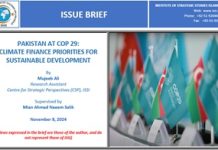Background
The earth’s climate has been evolving since it came into being. However, the extreme climatic events observed in the 21st century, mainly due to increasing influence of human activities, have highlighted climate change as a global concern. The main measures of climate change include rise in global temperature and spatio-temporal variations in precipitation patterns. Climate change is hitting water resources of world catastrophically as the ice covers are decreasing, sea levels are rising, heat waves are more frequent and rainfall patterns are shifting due to global warming, affecting some nations more than others in terms of magnitude and rate of change.[1] According to the Global Climate Risk Index published by non-profit group German watch, Pakistan is one of the most vulnerable nations in the world when it comes to the effects of climate change over the past two decades with eighth rank among most affected countries.[2] Pakistan has suffered tremendously in terms of lives as well as economic losses due to recurrent extreme weather events such as floods, droughts, cyclones, glacial lake outbursts, cloud bursts and heatwaves. While speaking at a summit “The Future Summit – What’s Coming Next”, Dr. Shamshad Akhtar, Chairperson, Pakistan Stock Exchange stated that climate change has cost Pakistan about $3.8 billion annual economic losses over the last two decades.[3] The monsoon floods of 2010 alone killed more than 1600 people, inundating over 20 percent land and causing damage worth roughly $10 billion.[4]
















